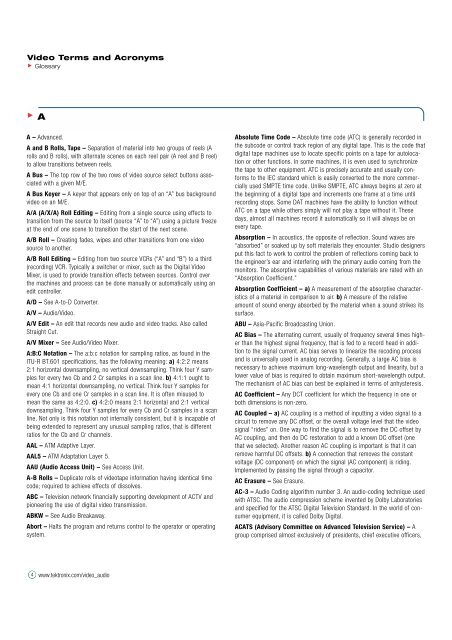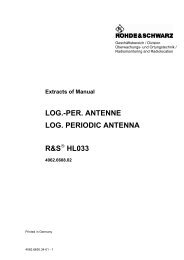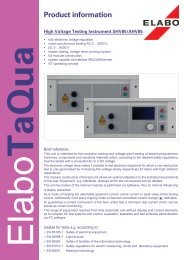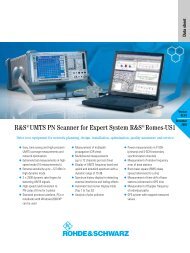Glossary of Video Terms and Acronyms - Isotest
Glossary of Video Terms and Acronyms - Isotest
Glossary of Video Terms and Acronyms - Isotest
Create successful ePaper yourself
Turn your PDF publications into a flip-book with our unique Google optimized e-Paper software.
<strong>Video</strong> <strong>Terms</strong> <strong>and</strong> <strong>Acronyms</strong><br />
<strong>Glossary</strong><br />
A–Advanced.<br />
A <strong>and</strong> B Rolls, Tape – Separation <strong>of</strong> material into two groups <strong>of</strong> reels (A<br />
rolls <strong>and</strong> B rolls), with alternate scenes on each reel pair (A reel <strong>and</strong> B reel)<br />
to allow transitions between reels.<br />
A Bus – The top row <strong>of</strong> the two rows <strong>of</strong> video source select buttons associated<br />
with a given M/E.<br />
A Bus Keyer – A keyer that appears only on top <strong>of</strong> an “A” bus background<br />
video on an M/E.<br />
A/A (A/X/A) Roll Editing – Editing from a single source using effects to<br />
transition from the source to itself (source “A” to “A”) using a picture freeze<br />
at the end <strong>of</strong> one scene to transition the start <strong>of</strong> the next scene.<br />
A/B Roll – Creating fades, wipes <strong>and</strong> other transitions from one video<br />
source to another.<br />
A/B Roll Editing – Editing from two source VCRs (“A” <strong>and</strong> “B”) to a third<br />
(recording) VCR. Typically a switcher or mixer, such as the Digital <strong>Video</strong><br />
Mixer, is used to provide transition effects between sources. Control over<br />
the machines <strong>and</strong> process can be done manually or automatically using an<br />
edit controller.<br />
A/D – See A-to-D Converter.<br />
A/V – Audio/<strong>Video</strong>.<br />
A/V Edit – An edit that records new audio <strong>and</strong> video tracks. Also called<br />
Straight Cut.<br />
A/V Mixer – See Audio/<strong>Video</strong> Mixer.<br />
A:B:C Notation – The a:b:c notation for sampling ratios, as found in the<br />
ITU-R BT.601 specifications, has the following meaning: a) 4:2:2 means<br />
2:1 horizontal downsampling, no vertical downsampling. Think four Y samples<br />
for every two Cb <strong>and</strong> 2 Cr samples in a scan line. b) 4:1:1 ought to<br />
mean 4:1 horizontal downsampling, no vertical. Think four Y samples for<br />
every one Cb <strong>and</strong> one Cr samples in a scan line. It is <strong>of</strong>ten misused to<br />
mean the same as 4:2:0. c) 4:2:0 means 2:1 horizontal <strong>and</strong> 2:1 vertical<br />
downsampling. Think four Y samples for every Cb <strong>and</strong> Cr samples in a scan<br />
line. Not only is this notation not internally consistent, but it is incapable <strong>of</strong><br />
being extended to represent any unusual sampling ratios, that is different<br />
ratios for the Cb <strong>and</strong> Cr channels.<br />
AAL – ATM Adaptive Layer.<br />
AAL5 – ATM Adaptation Layer 5.<br />
AAU (Audio Access Unit) – See Access Unit.<br />
A-B Rolls – Duplicate rolls <strong>of</strong> videotape information having identical time<br />
code; required to achieve effects <strong>of</strong> dissolves.<br />
ABC – Television network financially supporting development <strong>of</strong> ACTV <strong>and</strong><br />
pioneering the use <strong>of</strong> digital video transmission.<br />
ABKW – See Audio Breakaway.<br />
Abort – Halts the program <strong>and</strong> returns control to the operator or operating<br />
system.<br />
4<br />
A<br />
www.tektronix.com/video_audio<br />
Absolute Time Code – Absolute time code (ATC) is generally recorded in<br />
the subcode or control track region <strong>of</strong> any digital tape. This is the code that<br />
digital tape machines use to locate specific points on a tape for autolocation<br />
or other functions. In some machines, it is even used to synchronize<br />
the tape to other equipment. ATC is precisely accurate <strong>and</strong> usually conforms<br />
to the IEC st<strong>and</strong>ard which is easily converted to the more commercially<br />
used SMPTE time code. Unlike SMPTE, ATC always begins at zero at<br />
the beginning <strong>of</strong> a digital tape <strong>and</strong> increments one frame at a time until<br />
recording stops. Some DAT machines have the ability to function without<br />
ATC on a tape while others simply will not play a tape without it. These<br />
days, almost all machines record it automatically so it will always be on<br />
every tape.<br />
Absorption – In acoustics, the opposite <strong>of</strong> reflection. Sound waves are<br />
“absorbed” or soaked up by s<strong>of</strong>t materials they encounter. Studio designers<br />
put this fact to work to control the problem <strong>of</strong> reflections coming back to<br />
the engineer’s ear <strong>and</strong> interfering with the primary audio coming from the<br />
monitors. The absorptive capabilities <strong>of</strong> various materials are rated with an<br />
“Absorption Coefficient.”<br />
Absorption Coefficient – a) A measurement <strong>of</strong> the absorptive characteristics<br />
<strong>of</strong> a material in comparison to air. b) A measure <strong>of</strong> the relative<br />
amount <strong>of</strong> sound energy absorbed by the material when a sound strikes its<br />
surface.<br />
ABU – Asia-Pacific Broadcasting Union.<br />
AC Bias – The alternating current, usually <strong>of</strong> frequency several times higher<br />
than the highest signal frequency, that is fed to a record head in addition<br />
to the signal current. AC bias serves to linearize the recoding process<br />
<strong>and</strong> is universally used in analog recording. Generally, a large AC bias is<br />
necessary to achieve maximum long-wavelength output <strong>and</strong> linearity, but a<br />
lower value <strong>of</strong> bias is required to obtain maximum short-wavelength output.<br />
The mechanism <strong>of</strong> AC bias can best be explained in terms <strong>of</strong> anhysteresis.<br />
AC Coefficient – Any DCT coefficient for which the frequency in one or<br />
both dimensions is non-zero.<br />
AC Coupled – a) AC coupling is a method <strong>of</strong> inputting a video signal to a<br />
circuit to remove any DC <strong>of</strong>fset, or the overall voltage level that the video<br />
signal “rides” on. One way to find the signal is to remove the DC <strong>of</strong>fset by<br />
AC coupling, <strong>and</strong> then do DC restoration to add a known DC <strong>of</strong>fset (one<br />
that we selected). Another reason AC coupling is important is that it can<br />
remove harmful DC <strong>of</strong>fsets. b) A connection that removes the constant<br />
voltage (DC component) on which the signal (AC component) is riding.<br />
Implemented by passing the signal through a capacitor.<br />
AC Erasure – See Erasure.<br />
AC-3 – Audio Coding algorithm number 3. An audio-coding technique used<br />
with ATSC. The audio compression scheme invented by Dolby Laboratories<br />
<strong>and</strong> specified for the ATSC Digital Television St<strong>and</strong>ard. In the world <strong>of</strong> consumer<br />
equipment, it is called Dolby Digital.<br />
ACATS (Advisory Committee on Advanced Television Service) – A<br />
group comprised almost exclusively <strong>of</strong> presidents, chief executive <strong>of</strong>ficers,





